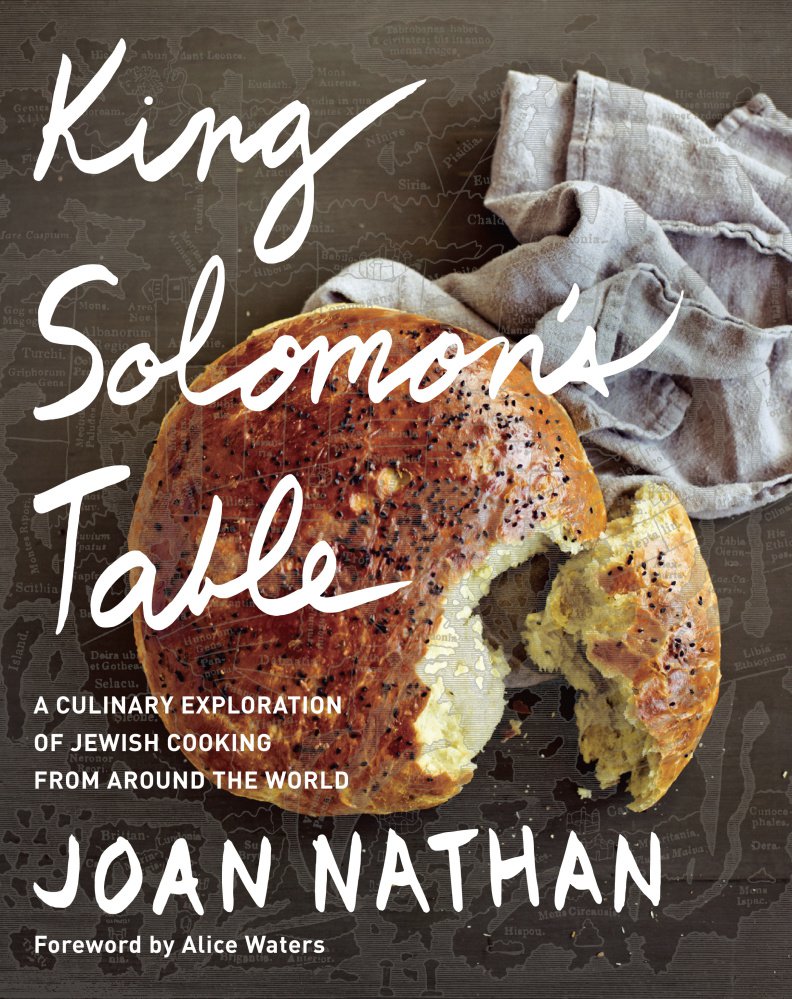“King Solomon’s Table: A Culinary Exploration of Jewish Cooking from Around the World.” By Joan Nathan. Knopf. $35.
“King Solomon’s Table: A Culinary Exploration of Jewish Cooking from Around the World” is a big, handsome volume that, like writer Joan Nathan’s previous works, is both authoritative and engaging. If she hasn’t 100 percent cornered the American market on Jewish cooking, Nathan is unquestionably its reigning queen.
Here, she adheres to her usual research method: She travels around the world, steps into the kitchens of Jewish cooks – typically home cooks – shares their food, listens to their tales and brings the recipes (and stories) back to her own Washington, D.C., kitchen to translate them for American cooks.
Nathan has written 11 hefty, thoroughly researched cookbooks, and her energy and curiosity never flag. In “King Solomon’s Table,” we trail her from England to India, France to Italy, Greece to Morocco. We meet Iraqi and Hungarian cooks, Colombian and Danish cooks, Cuban, Georgian and Israeli cooks.
We run into famed chefs like Jean-Louis Palladin and Michael Solomonov, famed rabbis like Moses Maimonides, famed biblical verse from the Song of Songs and Genesis. The recipes reflect Nathan’s globe-trotting and her wide-ranging scholarship, from the brisket, challah and rugelach that I grew up with in a suburb of Philadelphia in the 1970s to the Cashew Nut Strudel with Guava and Lime and the Sri Lankan Breakfast Buns with Onion Confit that I decidedly did not. Even with the less exotic (to me) recipes, Nathan adds many interesting twists. She mixes fennel seeds with the more usual poppy and sesame seeds that coat her challah; she fills a babka with exotically spiced quince; she makes latkes out of sweet potatoes and serves them with Yemenite hot sauce (zhug).
Some of the recipes are threaded with sorrow. Nathan asks a Parisian Jewish chef why putterkuchen, or butter crumble cake, is his favorite. “I think about my grandmother, who I never knew,” he says (she died in a concentration camp, Nathan writes). “It is not the taste I am searching for but the memories.”
Wherever Jews went – and they went everywhere – they brought their food with them, adapting it to the ingredients, traditions and seasons of their new homes. In the introduction to “King Solomon’s Table,” Nathan writes “A Brief History of Jewish Food” comparing that shape-shifting to a bagel:
“A mass of flour, water, salt, and yeast is combined to form a dough; and so too Jewish cuisine has been created, using ingredients and techniques local to its people. As the dough is rolled and stretched, so the people, and their cuisine begin to spread. New ideas, new foods and new recipes are picked up along the way. Eventually, the rope is tapered at the end; the recipes and techniques at one end seem quite different from the other. But then, with a twist of a wrist and a pinch of the fingers, the beginning and the end of the rope are united – the cuisine goes back to its roots, simultaneously, incorporating the new tricks learned along the way and enriching other cuisines.”
I tested three recipes from “King Solomon’s Table” and look forward to trying many more. The Tahina Cookies knocked it out of the park, winning over even many doubters. “They taste like a cross between a peanut butter cookie and a Russian tea cake,” a non-sweets-eating colleague said as she devoured her third cookie.
If the Roman Ricotta Cheese Crostata with Cherries or Chocolate (or both, as I did) had a little too much filling to fit into my tart pan, it was definitely too much of a very good thing. And the Socca (Chickpea Pancakes with Fennel, Onion and Rosemary), made a reasonably fast (though you must schedule time for the batter to sit), tasty and attractive dinner for two.
I already owned several of Nathan’s cookbooks when I picked up this one. Uniformly excellent as her cookbooks are, I was certain I didn’t need to add it to my personal collection. I was wrong.

TAHINA COOKIES
From Joan Nathan’s “King Solomon’s Table.”
Yield: About 3 dozen cookies
8 tablespoons (1 stick/113 grams) unsalted butter, at room temperature, or 1/2 cup (120 ml) vegetable oil
1/2 cup (100 grams) sugar
1 cup (135 grams), plus 2 tablespoons flour, sifted
1/4 teaspoon salt
1/2 teaspoon baking powder
1 teaspoon vanilla extract
1/2 cup (120 ml) tahina (tahini)
1/4 cup (20 grams) blanched and peeled almonds
1. Preheat the oven to 350 degrees F and line two baking sheets with parchment paper.
2. In the bowl of a standing mixer with a paddle attachment, cream the butter or oil and sugar. Mix in the flour, salt, and baking powder, then the vanilla and the tahina.
3. Roll the dough into balls about the size of a large marble and put on the parchment-lined baking sheets. Press an almond in the center of each, slightly flattening the cookies.
4. Bake for 15 to 20 minutes, rotating the sheets halfway through, until lightly golden and beginning to crisp.
Send questions/comments to the editors.




Comments are no longer available on this story